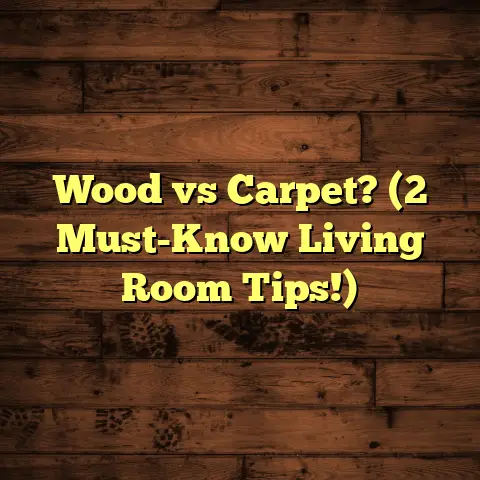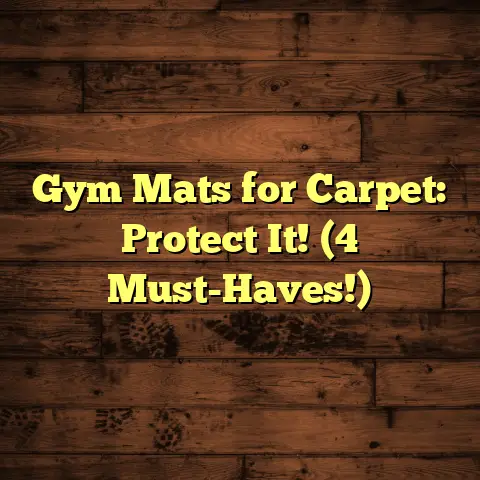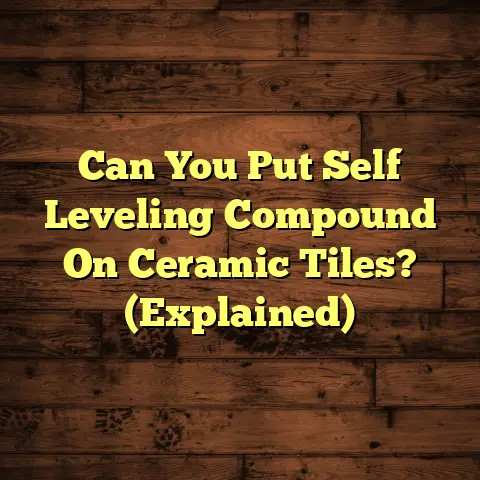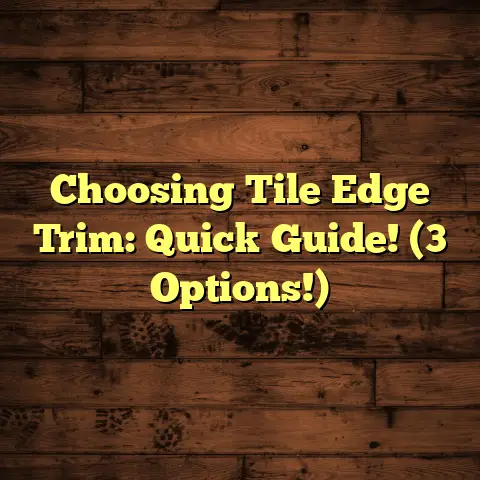Lifeproof Vinyl Reviews: Worth It? (8 Things!)
Have you ever been lost in the aisles of a home
improvement store, staring at endless flooring
options?
I know I have!
It’s easy to get
overwhelmed, especially when you start wondering
if that vinyl flooring is really worth the
investment.
Let’s dive into Lifeproof vinyl
and see if it lives up to the hype.
1. Overview of Lifeproof Vinyl Flooring
Lifeproof is a brand exclusively sold at Home Depot.
It’s become a pretty popular choice for homeowners
looking for a durable and budget-friendly flooring
solution.
They’ve carved out a nice market position
by focusing on waterproof and easy-to-install
products.
Lifeproof primarily offers two types of vinyl flooring:
-
Luxury Vinyl Planks (LVP): These mimic the look of hardwood, coming in long, narrow planks.
-
Luxury Vinyl Tiles (LVT): These resemble stone or ceramic tiles, often square or rectangular.
Lifeproof is generally targeted towards residential
use.
While some lines might be suitable for light
commercial applications, it’s mainly designed for
homes, apartments, and condos.
2. Durability and Performance
Okay, let’s get down to the nitty-gritty: how tough
is this stuff?
Lifeproof boasts impressive
resistance to scratches, dents, and, most
importantly, moisture.
The key factor here is the wear layer thickness.
This is the transparent top layer that protects the
flooring from daily wear and tear.
Lifeproof
typically offers wear layers ranging from 6 mil to
22 mil.
Generally speaking:
- 6-12 mil: Good for low-traffic areas like bedrooms or guest rooms.
- 12-20 mil: Suitable for most residential areas, including living rooms and kitchens.
- 20+ mil: Ideal for high-traffic areas or light commercial use.
I’ve seen countless online testimonials praising
Lifeproof’s ability to withstand kids, pets, and
spills.
One reviewer on Home Depot’s website
mentioned how their Lifeproof flooring survived a
major plumbing leak without any damage.
That’s
pretty impressive!
3. Installation Process
One of Lifeproof’s biggest selling points is its
DIY-friendly installation.
Most of their products
feature a click-lock system, meaning the planks or
tiles snap together without the need for glue or
nails.
There are typically two main installation methods:
-
Floating: This is the click-lock method, where the flooring “floats” above the subfloor.
Glue-Down: Some Lifeproof products can be glued directly to the subfloor for a more permanent installation.
This is often recommended for larger areas or commercial settings.
From my experience, the click-lock system is pretty
straightforward.
You’ll need basic tools like a
utility knife, measuring tape, and possibly a tapping
block and pull bar.
However, keep in mind that proper subfloor
preparation is crucial.
The subfloor needs to be
level, clean, and dry.
Any imperfections can telegraph
through the vinyl flooring and cause issues down the
road.
I always recommend watching a few YouTube tutorials
before tackling a Lifeproof installation.
It can save
you a lot of headaches.
4. Aesthetic Appeal
Let’s face it: nobody wants flooring that looks
cheap.
Fortunately, Lifeproof offers a wide range of
styles, colors, and finishes to suit different tastes.
You’ll find options that mimic:
-
Hardwood: Oak, maple, hickory, and more. They come in various plank widths and lengths.
-
Stone: Slate, travertine, marble, and even concrete looks.
-
Tile: Ceramic and porcelain tile imitations, often with grout lines printed on the surface.
Lifeproof’s color palette is pretty diverse, ranging
from light and airy neutrals to dark and dramatic
tones.
They also offer different textures, such as
embossed or hand-scraped finishes, to add a more
realistic look.
I’ve seen Lifeproof used in all sorts of homes, from
modern minimalist apartments to rustic farmhouse
renovations.
It’s versatile enough to complement a
wide range of aesthetics.
5. Maintenance Requirements
One of the great things about vinyl flooring is that
it’s relatively low-maintenance.
Lifeproof is no
exception.
Here’s a basic rundown:
-
Regular Sweeping or Vacuuming: This removes loose dirt and debris that can scratch the surface.
Damp Mopping: Use a mild detergent and warm water to clean the floor.
Avoid harsh chemicals or abrasive cleaners.-
Spot Cleaning: Wipe up spills immediately to prevent staining.
Lifeproof recommends using their own brand of
cleaner, but I’ve found that most pH-neutral floor
cleaners work just fine.
The key is to avoid anything
too acidic or alkaline, as it can damage the wear
layer.
I’ve heard from users that Lifeproof is pretty easy
to keep clean, even with kids and pets.
One tip I
always give is to use floor protectors under furniture
legs to prevent scratches.
6. Cost Consideration
Alright, let’s talk money.
Lifeproof is generally
positioned as a mid-range flooring option.
It’s
typically more expensive than basic sheet vinyl but
less expensive than hardwood or high-end tile.
As of today, you can expect to pay anywhere from
$3 to $5 per square foot for Lifeproof vinyl
flooring.
Keep in mind that prices can vary depending
on the style, wear layer thickness, and retailer
promotions.
Here’s a quick comparison to other flooring options:
When considering the ROI (Return on Investment),
Lifeproof can be a smart choice.
It offers a good
balance of durability, aesthetics, and affordability.
Plus, its waterproof properties can be a major selling
point if you ever decide to sell your home.
7. Customer Feedback and Reviews
Okay, I’ve given you my take, but what are other
people saying?
I’ve scoured online reviews from Home
Depot, Amazon, and other sources to get a sense of
overall customer satisfaction.
Here’s a summary of common praises:
Waterproof: This is the most frequently cited benefit.
People love that Lifeproof can withstand spills, pet accidents, and even flooding.-
Easy Installation: Many DIYers appreciate the click-lock system and find it relatively easy to install.
-
Durability: Customers report that Lifeproof holds up well to daily wear and tear, even in high-traffic areas.
-
Aesthetics: People are generally happy with the look and feel of Lifeproof, especially the realistic wood and stone imitations.
Of course, there are also some common complaints:
-
Subfloor Preparation: Some users struggle with proper subfloor preparation, which can lead to installation issues.
-
Click-Lock Problems: A few reviewers report that the click-lock system can be finicky and difficult to engage in certain areas.
Appearance of Scratches: While Lifeproof is scratch-resistant, it’s not scratch-proof.
Some users notice scratches over time, especially in high-traffic areas.
Overall, Lifeproof seems to have a pretty positive
reputation.
On Home Depot’s website, many Lifeproof
products have an average rating of 4 out of 5 stars
or higher.
8. Conclusion: Is Lifeproof Vinyl Worth It?
So, after all that, is Lifeproof vinyl worth it?
The
answer, as always, depends on your specific needs and
preferences.
Here’s a quick recap of the pros:
- Waterproof and moisture-resistant
- DIY-friendly installation
- Durable and long-lasting
- Wide range of styles and colors
- Relatively affordable
And here are the cons:
- Requires proper subfloor preparation
- Click-lock system can be finicky
- Not completely scratch-proof
- Limited availability (exclusively at Home Depot)
If you’re looking for a durable, waterproof, and
relatively affordable flooring option that you can
install yourself, Lifeproof is definitely worth
considering.
However, if you’re after the ultimate
luxury and don’t mind spending more, you might want
to explore other options like hardwood or high-end
tile.
Ultimately, the best way to decide is to visit your
local Home Depot, check out the Lifeproof samples in
person, and see if they meet your aesthetic and
functional requirements.
And don’t forget to read
plenty of online reviews to get a well-rounded
perspective.





